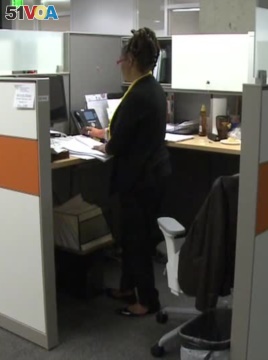May 29,2014
You can’t tell by looking at her, but Michelle Baxter suffers from chronic pain in her muscles and joints. She now spends her work day standing at her desk as a remedy for fibromyalgia.
"Since I’ve been standing my lower lumbar feels much better and, plus, I get to exercise and move more and to have everything circulate in the blood," she said. "It feels good.

Baxter works with student records at the George Washington University in the nation’s capital. Her switch to a standing desk has given her more energy and made her more productive.
“I can get more done, not even [having to be] stiff and get up and trying to find a place to exercise," she said. "So I’m moving, I’m exercising as I’m standing.”
And she is burning as many as 1,200 calories a day. That's one reason standing desks are slowly moving into cramped cubicles.
Research shows the more you sit, the greater your risk for major illness, says Amanda Visek, an exercise psychologist with the Milken Institute School of Public Health at GW.
“It causes a number of poor health outcomes including overweight, obesity, type 2 diabetes, cardiovascular disease, hypertension, depression, even mortality,” Visek said.
As a young woman, Visek developed hip and back pain from sitting. Since she converted to a standing desk, she feels better and has more energy.
“I could even work a 10-hour work day and still feel good at the end of the day," Visek said, "instead of feeling lethargic and you just want to go home and then engage in more sedentary activities by lying on the couch.
One study finds that for older adults, every hour spent sitting is linked to a 50 percent greater risk of becoming disabled. But no one at any age is spared.
“Even if we do make it to the gym at the end of the day and we go for a run and do other things, if we spend the majority of our day sitting in sedentary behavior, that is its own independent risk factor," Visek said. "One is not the remedy for the other.”
So if exercise does not compensate for sitting, what does? Visek suggests building activity into your daily routine.
“In the workplace, instead of shooting off an e-mail or picking up the phone to call a colleague, you can walk to their office to ask the same question or have the same conversation," she said. "One of the things that we can train ourselves to do when we enter a building is to take the staircase first and look for that. That’s an easy substitution in building steps into our day in lieu of riding the elevator up.”
The Milken Institute School of Public Health promotes this vision. The central staircase encourages taking the steps, elevated tables in classrooms and lounge areas provide the option to stand and all faculty members have standing desks.
Baxter says she takes the long way to the photocopier or to get a cup of coffee. What seems like such a small thing has changed her life and prompted her to offer this advice:
“Everybody stand," she said. "It’s good. It’s good for you. Everybody stand, just for a little while. Try it."